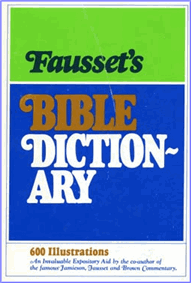Fausset's Bible Dictionary
A B C D E F G H I J K L M N O P Q R S T U V W X Y Z
Olive
Its foliage is the earliest mentioned (Genesis 8:11). Tradition from Noah's days has ever made it symbolize peace. It is the emblem of "fatness" in the oldest parable (Judges 9:8-9). Emblem of the godly (Psalm 52:5; Psalm 52:8), in spirit constantly dwelling "in the house of God"; in contrast to slave-like formalists now sojourning outwardly in it for a time, but not abiding ever (John 8:34-35; Psalm 15:1; Psalm 23:6; Psalm 27:4-5; Psalm 36:8); the wicked and antichrist shall be "rooted out of (God's) dwelling place," literally, 5 ('ohel). The Septuagint, Chaldee, Vulgate, and Aben Ezra interpret 'ohel "the tabernacle" (2 Thessalonians 2:4; Daniel 11:44-45). The saint's children are "like olive plants round about his table" (Psalm 128:3).
The old olive sends out young suckers which spring up round the parent tree, and which in after ages, when the parent's strength fails, shelter it on every side from the blast. It is the characteristic tree of Judea on Roman coins, Deuteronomy 8:8. Asher "dipped his foot in oil" (Deuteronomy 33:24). Emblem of Judah's adoption of God by grace (Jeremiah 11:16; Romans 11:17), also of joy and prosperity. The Gentile church is the wild twig "engrafted contrary to nature" on the original Jewish olive stock; it marks supernatural virtue in the stock that it enables those wild by nature to bear good fruit; ordinarily it is only a superior scion that is grafted on an inferior. The two witnesses for God (antitypes to Elijah and Moses, Zerubbabel and Joshua, the civil ruler and the priest: Malachi 4:5-6; Matthew 17:11; Acts 3:21; Judges 1:6) are "the two olive trees," channels of the oil (the Holy Spirit in them) feeding the church (Revelation 11:3-4; Zechariah 4:11-12).
The wood, fine grained, solid, and yellowish, was used for the cherubim, doors, and posts (1 Kings 6:23; 1 Kings 6:31-33). The tree was shaken to get the remnant left after the general gathering (by "beating," Deuteronomy 24:20), Isaiah 24:13; image of Israel's "remnant according to the election of grace." The least breeze makes the flowers fall; compare Job 15:33, "he shall cast off his flower as the olive," i.e. the least blast sweeps away in a moment the sinner's prosperity. The tree poetically is made to cast off its own blossom, to mark that the sinner brings on his own ruin (Isaiah 3:11; Jeremiah 6:19). It thrives best in a sunny position. A rocky calcareous subsoil suits it; compare "oil out of the flinty rock" (Deuteronomy 32:13). The trunk is knotty and gnarled, the bark smooth and ash colored. Its growth is slow, but it lives very long. The leaves are grey green, not deciduous, suggestive of tenacious strength.
Bibliography Information
Fausset, Andrew Robert M.A., D.D., "Definition for 'olive' Fausset's Bible Dictionary".
bible-history.com - Fausset's; 1878.
Copyright Information
© Fausset's Bible Dictionary
Fausset's Bible Dictionary Home
Bible History Online Home
Bible Encyclopedia (ISBE)
Online Bible (KJV)
Naves Topical Bible
Smith's Bible Dictionary
Easton's Bible Dictionary
Schaff's Bible Dictionary
Fausset's Bible Dictionary
Matthew Henry Bible Commentary
Hitchcock's Bible Dictionary

Dr. A.R. Fausset
Popular and Trending:
Meaning and definition of fasting, what is fasting in the bible, fasting definition, why should I fast, the power of prayer and fasting, Location of Galilee, where was galilee in the bible?, fasting definition, Galilee region, cities of Galilee, Sea of Galilee, Definition of biblical fire, what is fire in the bible?, fire and brimstone, fire meaning, baking bread with fire, Definition of the biblical firmament in Genesis, what is the firmament in the bible?, was the firmament the third heaven, firmament meaning, did the firmament bring the flood of Noah?.
